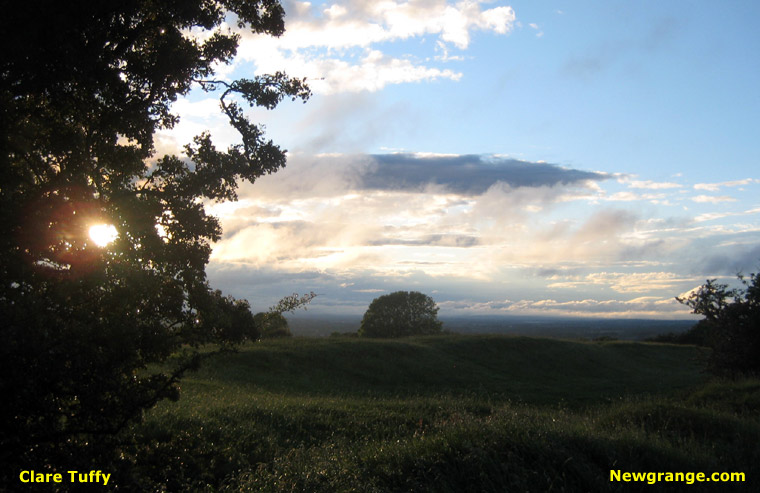Walks and talks on Hill of Tara
2.30 - 4.00 pm Walking tour
(led by Conor Newman NUI, Galway and Heritage Council).
Convene at the gate.
6.00 - 6.45 pm Tara: space, monuments and symbolism
(Conor Newman NUI, Galway and Heritage Council).
Venue: Church on Tara
Wednesday 27th July 2010
4.00 - 5.00pm Walking tour on natural heritage on Hill of Tata
(led by Neil Foulkes Hedgerow conservator, Hedge Laying Association of Ireland).
Convene at the gate.
7.00 - 8.00 pm Remote sensing at Irish royal sites
(Tara; Uisneach; Dun Ailinne; Cruachain)
Roseanne Schot and Joe Fenwick NUI, Galway;
Anthony Corns and Robert Shaw, Discovery Programme.)
Venue: Church on Tara
Wednesday 28th July 2010
2.30 - 4.00 pm Walking tour
(led by Edel Bhreathnach and Mícheál Ó Cléirigh, Institute, UCD).
Convene at the gate.
6.00 - 6.45 pm Tara: kingship, politics and religion ,
(Edel Bhreathnach and Mícheál Ó Cléirigh, Institute, UCD).
Venue: Church on Tara.
Please wear appropriate footwear for the walking tour and a raincoat or an umbrella in case it rains!
Speakers
Conor Newman has studied the archaeology of Tara for 18 years. He was director of the Discovery Programme's survey of Tara and is chairman of the Heritage Council. His talk will focus on the creation of religious space at Tara.Edel Bhreathnach directed the Discovery Programme's historical analysis of Tara . She is the academic project manager at the Mícheál Ó Cléirigh Institute, UCD. Her talk will focus on the convergence of politics and religion in the kingship of Tara.
Roseanne Schot is an assistant lecturer at the department of Archaeology, NUI, Galway . She specialises in the archaeology and history of Uisneach, the sacred ‘centre' of ancient Ireland . Her talk will describe her work at Uisneach through the prism of geophysics.
Joe Fenwick was senior surveyor on the Discovery Programme's Tara survey and on NUI Galway's research project at Rathcroghan. He too specialises in the archaeology of early royal sites and headed up the geophysical survey of Tara for the last 10 years. His talk will focus on the contribution of geophysics to our understanding of early royal sites.
Anthony Corns is the GIS & IT manager at the Discovery Programme. He specializes in the application of new technology to further our understanding of archaeology and our cultural past. His talk will focus on the use of GIS for the integration of remotely sensed data sets at Tara.
Robert Shaw is currently the principle geo-surveyor at the Discovery Programme. His areas of interest include the application of remote sending on the digital documentation of cultural heritage monuments and objects. His talk will focus on the surveying of Royal sites using aerial photogrammetry and LiDAR.
Neil Foulkes is secretary of the Hedge Laying Association of Ireland and will explore some of the natural features of Tara including the hedgerows. Neil has been involved in hedgerow conservation for over 20 years and was in 2010 was responsible for conducting a survey and producing a management plan for the OPW of the hedgerows at Tara.
The Hill of Tara
The Hill of Tara, located in County Meath, Ireland, holds immense significance as a sacred and historical site in Irish folklore, mythology, and archaeology.The Hill of Tara has been a central focal point in Irish history for millennia, serving as the ancient seat of the High Kings of Ireland. It is steeped in mythology, particularly associated with the Tuatha Dé Danann, ancient supernatural beings in Irish folklore. Tara was believed to be the inauguration site of the High Kings, where rituals and ceremonies were conducted to mark their ascension to power.
The Mound of the Hostages
This Neolithic passage tomb dates back to approximately 3,000 BCE, making it the oldest structure on the Hill of Tara. It is contemporary with passages tombs at the bend of the Boyne, namely Newgrange, Knowth and Dowth.The Lia Fáil
The Lia Fáil also known as the Stone of Destiny is located on the Inauguration Mound (also known as the Forrad), the Lia Fáil is a standing stone believed to have magical properties. According to legend, the stone would roar when the rightful king touched it, affirming his legitimacy to rule.Rath of the Synods
This circular earthwork enclosure is named as a meeting place for early Christian synods and assemblies during the medieval period however the monument is much older. It consists of two concentric banks and ditches, suggesting its significance as a ceremonial site.Teach Chormaic
Teach Chormaic also known as Cormac's House is traditionally associated with Cormac mac Airt, a legendary High King of Ireland,Ráith na Ríogh
Ráith na Ríogh also known as the Royal Enclosure is a large circular earthen bank and ditch, it is believed to have been the political and ceremonial heart of Tara during its peak as the seat of the High Kings. It contains several earthworks and structures, including the Mound of the Hostages and the Forrad.Boyne Valley Private Day Tour
 Immerse yourself in the rich heritage and culture of the Boyne Valley with our full-day private tours.
Visit Newgrange World Heritage site, explore the Hill of Slane, where Saint Patrick famously lit the Paschal fire.
Discover the Hill of Tara, the ancient seat of power for the High Kings of Ireland.
Book Now
Immerse yourself in the rich heritage and culture of the Boyne Valley with our full-day private tours.
Visit Newgrange World Heritage site, explore the Hill of Slane, where Saint Patrick famously lit the Paschal fire.
Discover the Hill of Tara, the ancient seat of power for the High Kings of Ireland.
Book Now

